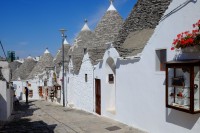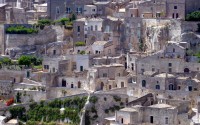Just back from a lovely week touring the Puglia region of Italy. Although this was an escorted coach tour and there were around fifty on the trip, it proved to be a reasonably relaxed affair. Normally, this type of travel would not be a preferred option for an old grump like me!
On this occasion, the coach tour proved to be the right choice to explore this relatively untouched (from a British point of view) corner of Italy. We managed to see a fair amount of the region in what amounted to only six full days; there was a fair amount of travelling, and yet there was always enough time for self exploration on top of the included guided tours, which were both informative and acted as useful pointers for your own exploration without the other fifty people in tow.

The first full day was given over to Lecce, apparently sometimes known as the Florence of the South. Full of stunning architecture that showcased its wealthy past, the old town in particular was full of local charm and rewarded a gentle amble around its side streets and lovely piazzas. Bari, the region’s administrative centre and largest town, was also full of fine buildings that betrayed its heritage as a major medieval port (and current ferry hub). On the same day we visited Bari, we spent the mid to late afternoon in Alberobello, a World Heritage Site and home of the wonderful Trulli houses, unique to the Apulia area. Originally of dry stone construction, so the local landowner could order the residents to dismantle them before government inspections so that he could avoid paying taxes, they are well worth seeing. One side of Alberobello is now quite well developed (e.g. full of “tourist shop Trullis”, but good luck to them, the owners need to make a living) but the other side also has fine examples of Trulli buildings, and is quieter and more residential in nature.

Next up was the ancient town of Matera, one of the first inhabited places in the whole of Italy and the site of some extraordinary ‘cave houses’. These are in the Sassi (ancient town) and are basically habitations dug into the rock itself, which is characteristic of Basilicata and Apulia. Many of them are really little more than caverns, and in some parts of the Sassi a street lies on top of another group of dwellings. One or two of the undeveloped houses have been preserved (along with an 11thC church) and so visitors can get an idea of living conditions for the residents, many of whom were still living here until the 1950s.
We also visited the coastal town of Trani, an important port in medieval times and one which still boasts some marvellous Romanesque architecture. Our final stop was Vieste, which to be fair is more of a typical coastal town with stunning beaches and a favourite holiday destination of the northern Italians. Having said that, it too has a lovely old town with a selection of houses (and restaurants) built into the natural caves. A very pleasant location to ‘chill out’, although we took the opportunity to visit Monte Sant Angelo, a hill top village with an 9thC abbey, which was built after a visitation by the Archangel Michael and now an important pilgrimage site.

All in all a very well organised tour with plenty of time for exploration and an excellent way to see a relatively unexplored part of Italy. The only real alternative would be self-drive, and, as we know, Italians have a certain stereotypical but not entirely undeserved reputation when it comes to their relationship with cars! Oh, and it didn’t matter where you went or what the establishment was, you could not get a bad cup of coffee anywhere, just various degrees of quality from very good to superb! My only tip for improvement would be to stay an extra day at Lecce and Matera (which were both worthy of further exploration) and cut down on the Vieste portion of the tour, but I suspect that, of those on the trip, I would most definitely be in the minority.
